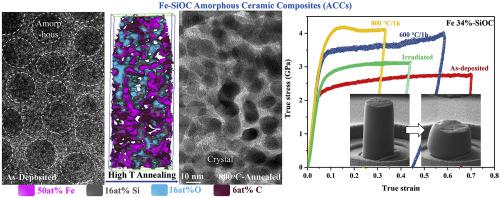当前位置:
X-MOL 学术
›
Int. J. Plasticity
›
论文详情
Our official English website, www.x-mol.net, welcomes your feedback! (Note: you will need to create a separate account there.)
Strength and plasticity of amorphous ceramics with self-patterned nano-heterogeneities
International Journal of Plasticity ( IF 9.8 ) Pub Date : 2020-11-01 , DOI: 10.1016/j.ijplas.2020.102837 Kaisheng Ming , Chao Gu , Qing Su , Dongyue Xie , Yaqiao Wu , Yongqiang Wang , Lin Shao , Michael Nastasi , Jian Wang
International Journal of Plasticity ( IF 9.8 ) Pub Date : 2020-11-01 , DOI: 10.1016/j.ijplas.2020.102837 Kaisheng Ming , Chao Gu , Qing Su , Dongyue Xie , Yaqiao Wu , Yongqiang Wang , Lin Shao , Michael Nastasi , Jian Wang

|
Abstract Amorphous ceramics with superb strength and irradiation tolerance are promising candidate materials for nuclear industry. However, the brittle-like behavior extremely limits their applications. Here, we demonstrate that Fe–SiOC amorphous ceramic composites (ACCs) with self-patterned Fe-rich nanoclusters fabricated by co-sputtering Fe and amorphous SiOC ceramic not only exhibits exceptional, homogeneous plasticity at room temperature but also remains high strength and good irradiation tolerance. Flow strength of Fe–SiOC ACCs decreases but plasticity increases with the increase in Fe content. Moreover, the strength and plasticity of Fe–SiOC ACCs can be further tailored by subsequent annealing and ion irradiation associated with the change in their microstructure. High temperature annealing tunes amorphous Fe-rich nanoclusters into crystalline Fe nanoparticles, significantly enhancing flow strength of Fe–SiOC ACCs without loss of plasticity. Ion irradiation does not apparently modify the microstructure and reduce plasticity of Fe34at.%-SiOC ACC, but slightly enhances their flow stress. For instance, annealed Fe34at.%-SiOC ACC has flow true stress exceeding 4.0 GPa at a large uniform compressive strain of 55% without plastic flow instability and cracking. The spatially distributed Fe-rich heterogeneities (amorphous nanoclusters and crystalline nanoparticles) plastically co-deform with amorphous SiOC matrix and discretize shear transformation zones in amorphous ceramics, thus preventing the shear-banding instability and significantly enhancing compressive plasticity. The plastic co-deformation between Fe-rich nano-heterogeneities and amorphous SiOC ceramic matrix is achieved due to interface constraint, preventing cracking and ensuring homogeneous plastic deformation of Fe–SiOC ACCs. These findings suggest that patterning nanoscale metal-rich heterogeneities can tailor mechanical properties of amorphous ceramics.
中文翻译:

具有自构图纳米异质性的非晶陶瓷的强度和塑性
摘要 具有优异强度和耐辐照性能的非晶陶瓷是有前途的核工业候选材料。然而,类似脆性的行为极大地限制了它们的应用。在这里,我们证明了通过共溅射 Fe 和非晶 SiOC 陶瓷制备的具有自图案化富铁纳米团簇的 Fe-SiOC 非晶陶瓷复合材料 (ACCs) 不仅在室温下表现出优异的均匀塑性,而且还保持高强度和良好的辐照宽容。Fe-SiOC ACCs 的流动强度随着 Fe 含量的增加而降低,但塑性增加。此外,Fe-SiOC ACCs 的强度和塑性可以通过随后的退火和与其微观结构变化相关的离子辐射来进一步调整。高温退火将非晶富铁纳米团簇调整为结晶铁纳米颗粒,显着提高了 Fe-SiOC ACCs 的流动强度而不损失可塑性。离子辐照并未明显改变 Fe34at.%-SiOC ACC 的微观结构并降低其塑性,但略微增强了它们的流动应力。例如,退火的 Fe34at.%-SiOC ACC 在 55% 的大均匀压缩应变下具有超过 4.0 GPa 的流动真应力,而没有塑性流动不稳定性和开裂。空间分布的富铁异质性(非晶纳米团簇和结晶纳米颗粒)与非晶SiOC基体发生塑性共变形,并离散化非晶陶瓷中的剪切转变区,从而防止剪切带不稳定性并显着增强压缩塑性。由于界面约束,实现了富铁纳米异质体和非晶SiOC陶瓷基体之间的塑性共变形,防止开裂并确保Fe-SiOC ACCs的均匀塑性变形。这些发现表明,图案化纳米级富含金属的异质性可以调整非晶陶瓷的机械性能。
更新日期:2020-11-01
中文翻译:

具有自构图纳米异质性的非晶陶瓷的强度和塑性
摘要 具有优异强度和耐辐照性能的非晶陶瓷是有前途的核工业候选材料。然而,类似脆性的行为极大地限制了它们的应用。在这里,我们证明了通过共溅射 Fe 和非晶 SiOC 陶瓷制备的具有自图案化富铁纳米团簇的 Fe-SiOC 非晶陶瓷复合材料 (ACCs) 不仅在室温下表现出优异的均匀塑性,而且还保持高强度和良好的辐照宽容。Fe-SiOC ACCs 的流动强度随着 Fe 含量的增加而降低,但塑性增加。此外,Fe-SiOC ACCs 的强度和塑性可以通过随后的退火和与其微观结构变化相关的离子辐射来进一步调整。高温退火将非晶富铁纳米团簇调整为结晶铁纳米颗粒,显着提高了 Fe-SiOC ACCs 的流动强度而不损失可塑性。离子辐照并未明显改变 Fe34at.%-SiOC ACC 的微观结构并降低其塑性,但略微增强了它们的流动应力。例如,退火的 Fe34at.%-SiOC ACC 在 55% 的大均匀压缩应变下具有超过 4.0 GPa 的流动真应力,而没有塑性流动不稳定性和开裂。空间分布的富铁异质性(非晶纳米团簇和结晶纳米颗粒)与非晶SiOC基体发生塑性共变形,并离散化非晶陶瓷中的剪切转变区,从而防止剪切带不稳定性并显着增强压缩塑性。由于界面约束,实现了富铁纳米异质体和非晶SiOC陶瓷基体之间的塑性共变形,防止开裂并确保Fe-SiOC ACCs的均匀塑性变形。这些发现表明,图案化纳米级富含金属的异质性可以调整非晶陶瓷的机械性能。



























 京公网安备 11010802027423号
京公网安备 11010802027423号